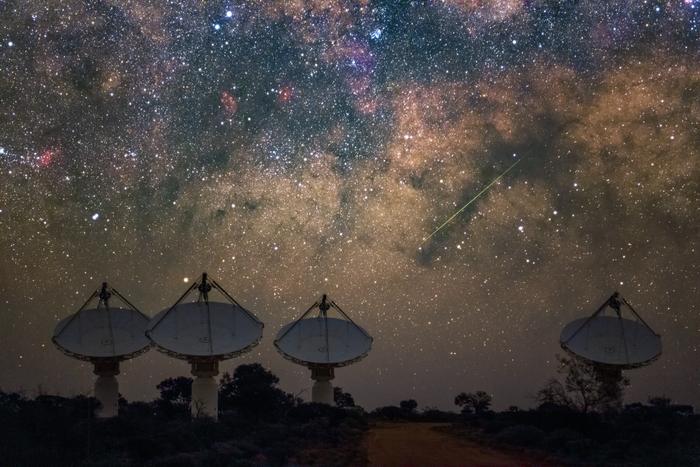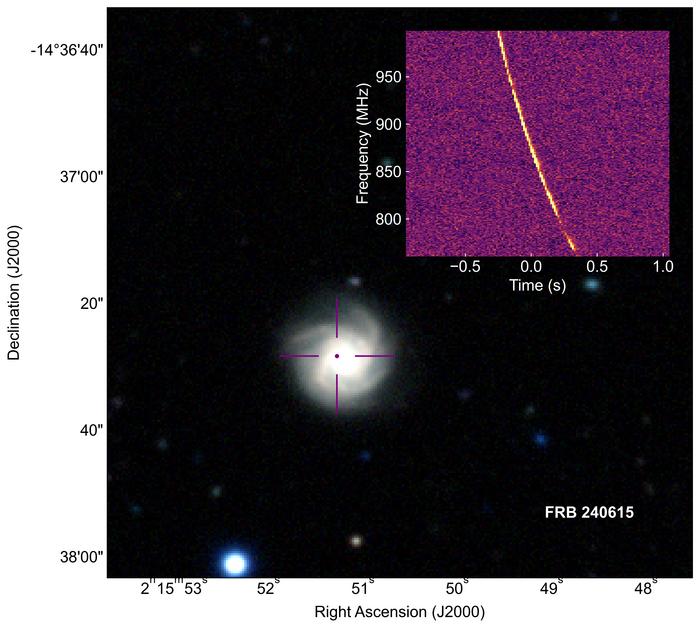Australian Innovation Sifts Space for Cosmic Mysteries

Australian Innovation Sifts Space for Cosmic Mysteries
The first trial of an Australian-developed technology has detected mysterious objects by sifting through signals from space like sand on a beach.
The first trial of an Australian-developed technology has detected mysterious objects by sifting through signals from space like sand on a beach.
Astronomers and engineers at CSIRO, Australia’s national science agency, developed the specialised system, CRACO, for their ASKAP radio telescope to rapidly detect mysterious fast radio bursts and other space phenomena.
The new technology has now been put to the test by researchers led by the Curtin University node of the International Centre for Radio Astronomy (ICRAR) in Western Australia.

Results published today in Publications of the Astronomical Society of Australia present the discovery of two fast radio bursts and two sporadically-emitting neutron stars, and improved location data of four pulsars, enabled by the new technology. They have since gone on to find more than twenty fast radio bursts.
Dr Andy Wang from ICRAR, who led the research group and tested CRACO, said the team had found more astronomical objects than expected.
“We were focused on finding fast radio bursts, a mysterious phenomenon that has opened up a new field of research in astronomy.
“CRACO is enabling us to find these bursts better than ever before. We have been searching for bursts 100 times per second and in the future we expect this will increase to 1,000 times per second,” Dr Wang said.

CSIRO astronomer and engineer Dr Keith Bannister who, along with his team, developed the instrument, says the scale of observation enabled by the new technology is enormous.
“CRACO taps into ASKAP’s ‘live’ view of the sky in search of fast radio bursts.
“To do this, it scans through huge volumes of data – processing 100 billion pixels per second – to detect and identify the location of bursts.
“That’s the equivalent of sifting through a whole beach of sand to look for a single five-cent coin every minute,” Dr Bannister said.

CRACO is made up of a cluster of computers and accelerators connected to the ASKAP radio telescope at Inyarrimanha Ilgari Bundara, the CSIRO Murchison Radio-astronomy Observatory on Wajarri Yamaji Country. Development of this technology reinforces Australia’s international reputation as a leader in radio astronomy engineering and research.
“Once at full capacity, CRACO will be a game changer for international astronomy,” Dr Wang said.
CRACO has been engineered to sift through the trillions of pixels received by the telescope to find anomalies, alerting researchers the moment it spots something out of the ordinary, allowing them to quickly follow up to obtain more data and complete their own analysis.
Dr Wang and his team increasingly expanded CRACO’s research targets to find more exotic sources.
“We’re also detecting long-period transients, which remain mysterious objects within our galaxy. Both fast radio bursts and these transients were first discovered in Australia, so it is great that we’re continuing the path of discovery with this impressive technology,” Dr Wang said.
CRACO will soon be made available to astronomers all over the world as part of CSIRO’s Australia Telescope National Facility, a suite of national research infrastructure which includes Murriyang, CSIRO’s Parkes radio telescope.

The CRACO system was developed through collaboration between CSIRO and Australian and international researchers and was partially funded through an Australian Research Council grant.
We acknowledge the Wajarri Yamaji as the Traditional Owners and Native Title Holders of Inyarrimanha Ilgari Bundara, the CSIRO Murchison Radio-astronomy Observatory site, where CRACO is located.
Original Source: https://www.icrar.org/craco/
Original Publication
Z. Wang, K. W. Bannister, V. Gupta, X. Deng, M. Pilawa, J. Tuthill, J. D. Bunton, C. Flynn, M. Glowacki, A. Jaini, Y. W. J. Lee, E. Lenc, J. Lucero, A. Paek, R. Radhakrishnan, N. Thyagarajan, P. Uttarkar, Y. Wang, N. D. R. Bhat, C. W. James, V. A. Moss, Tara Murphy, J. E. Reynolds, R. M. Shannon, L. G. Spitler, A. Tzioumis, M. Caleb, A. T. Deller, A. C. Gordon, L. Marnoch, S. D. Ryder, S. Simha, C. S. Anderson, L. Ball, D. Brodrick, F. R. Cooray, N. Gupta, D. B. Hayman, A. Ng, S. E. Pearce, C. Phillips, M. A. Voronkov, and T. Westmeier
Journal: Publications of the Astronomical Society of Australia
Method of Research: Meta-analysis
Article Title: The CRAFT Coherent (CRACO) upgrade I: System Description and Results of the 110-ms Radio Transient Pilot Survey
Article Publication Date: 28-Jan-2025
DOI: 10.1017/pasa.2024.107
Media Contact
Charlene D’Monte
International Centre for Radio Astronomy Research
communications@icrar.org
Cell: 0468 579 311
Source: EurekAlert!
All latest news from the category: Agricultural and Forestry Science
Newest articles

New Study Offers Hope for Chronic Pain Relief in Dialysis Patients
People undergoing hemodialysis treatment for kidney failure often experience chronic pain related to their condition, but it can be difficult to manage with opioid medication and other conventional treatments. A…

Early Adult Mortality Surges in Post-COVID US
New research from Boston University School of Public Health and the University of Minnesota shows that death rates for early adults, or adults aged 25-44, rose sharply during the COVID-19…

Recycling Lithium-Ion Batteries Boosts Supply Chain Resilience
Recycling lithium-ion batteries to recover their critical metals has significantly lower environmental impacts than mining virgin metals, according to a new Stanford University lifecycle analysis published in Nature Communications. On…



